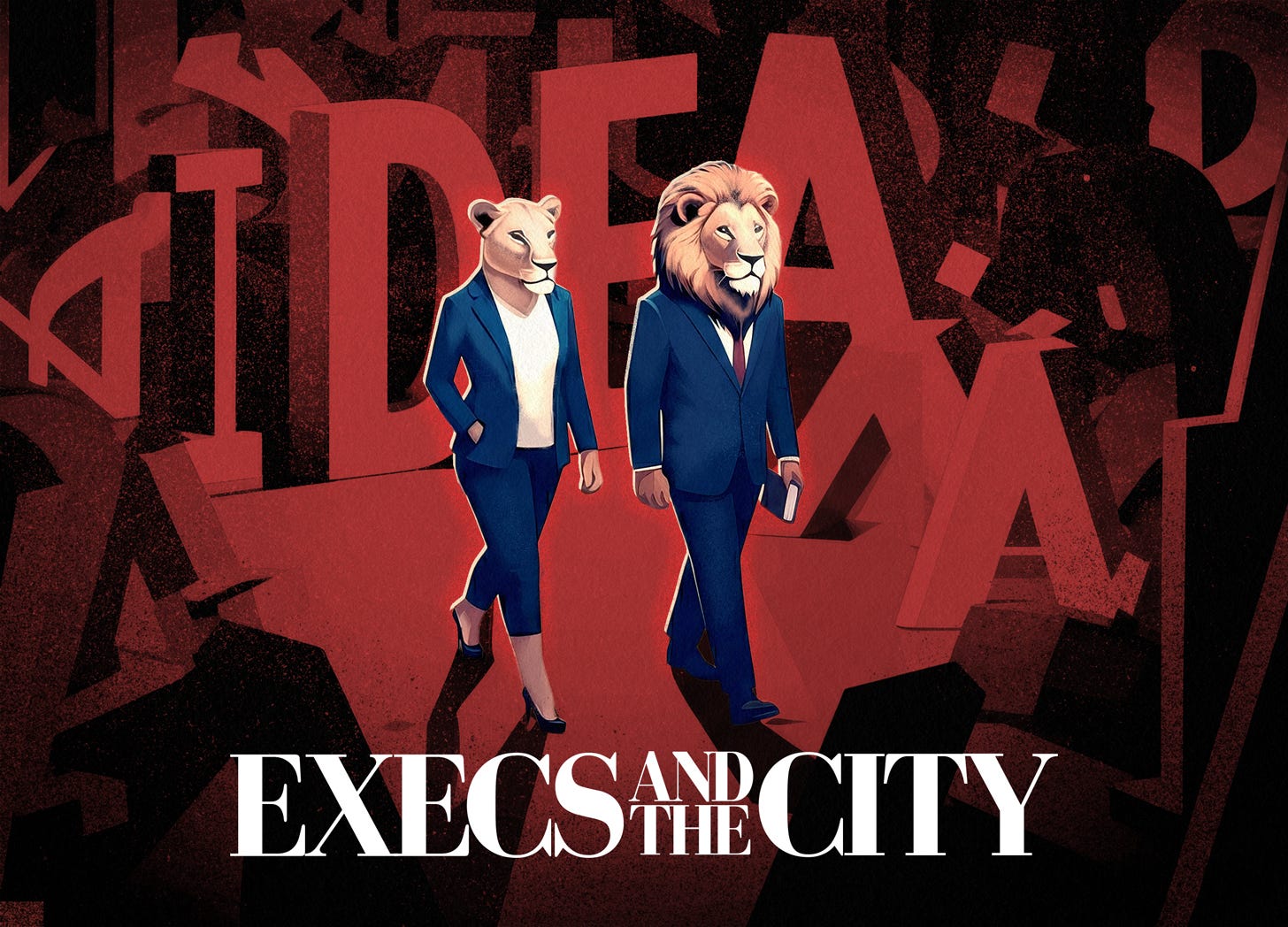The Rhetoric and Language of Influence
Technical brilliance is table stakes. Master the hidden language of executive influence—precision, framing, metaphors, and strategic questions—to shape perception and drive outcomes.
Welcome to Execs and the City, where we reveal how senior leaders really get paid, positioned, and promoted. Paid members get live office hours, dedicated career AI, our job search course, and more.
The board falls silent as you finish presenting your recommendation.
For weeks, you've analyzed data, built compelling models, and crafted a meticulous plan. Yet as you scan the room, you detect not enthusiasm but hesitation. The same plan presented by your colleague last quarter was approved immediately.
The uncomfortable truth? It's not your strategy that's failing—it's your rhetoric.
The gap in outcomes isn't accidental—it's linguistic.
I've witnessed this scene play out repeatedly across industries and functions. Technical brilliance alone doesn't translate to executive influence. There exists a hidden language that separates those who merely communicate from those who truly influence.
Most executives focus exclusively on what they say. The strongest leaders master how they say it.
Your language patterns do far more than convey information—they signal your capacity, shape how others perceive value, and ultimately determine whether your ideas gain traction or face resistance. This isn't just about eloquence or charisma—it's about specific, learnable rhetoric that positions you as a strategic asset rather than a tactical resource.
The uncomfortable reality?
Your communication approach is likely undermining your leadership position daily.
I've observed thousands of senior leaders across strategic conversations, board meetings, and pivotal presentations. The pattern is unmistakable—executives with nearly identical technical capabilities experience dramatically different outcomes based primarily on their rhetorical frameworks.
The strongest leaders don't simply speak—they use language that creates leverage.
Let me show you exactly how to develop the rhetoric that transforms how others perceive your contributions—and why it matters more in today's environment than ever before.
The Communication Imperative
The age of technical brilliance as a primary differentiator is over.
Artificial intelligence now performs complex analysis, generates polished deliverables, and solves technical problems with stunning efficiency. The skills that once separated senior professionals—analytical depth, domain expertise, and technical mastery—have become increasingly commoditized.
What remains uniquely human? Your ability to communicate strategically.
This isn't about prettier slides or well-rehearsed presentations. Strategic communication operates on a fundamentally different plane than the technical communication many executives rely on.
It’s not what you say...
...it’s how you say it.
Most executives never make this critical transition. They climb the career ladder through technical excellence, then continue applying the same communication approach at senior levels—and wonder why their influence plateaus precisely when it should be expanding.
Technical communication focuses on data accuracy and completeness. Strategic communication focuses on perception management and decision facilitation.
Compare these approaches:
Technical communicator: "Our research indicates a 73% probability of success based on market conditions and internal capabilities..."
Strategic communicator: "We've positioned ourselves for certain success by aligning our unique strengths with the market's most promising opportunities..."
The content is similar. The impact is worlds apart.
Technical language signals operational thinking. Strategic language signals leadership thinking.
This isn’t to suggest that you shouldn’t have the technical chops to back it up—I’m suggesting that you often don’t need to go into those details to win over a crowd.
Consider nearly every presidential campaign for reference.
The shift becomes even more critical in today's leadership landscape where:
Attention spans have collapsed, requiring more concentrated messaging
Decision cycles have accelerated, demanding clear framing
Information overload has increased, necessitating more distinctive communication
Remote work has flattened traditional authority signals, elevating language as a primary leadership indicator
Your approach to communication isn't just a matter of style—it's a fundamental strategic position that either amplifies or undermines everything else you bring to the table.
The most painful truth? Most executives have no idea how their communication is being perceived. They focus on content accuracy while remaining blind to the rhetorical signals they're broadcasting—signals that shape how others evaluate their leadership capacity.
The good news? Strategic rhetoric isn't an innate talent. It's a learnable skill composed of specific frameworks, techniques, and approaches that create outsized returns when applied consistently.
Let me show you the exact components that transform ordinary communication into strategic influence.
Component 1: Precision Language
Nothing undermines executive credibility faster than vague, meandering communication.
While mid-level professionals can hide behind jargon and ambiguity, senior leadership requires language that demonstrates clarity of thought. Precision language isn't about technical detail—it's about creating unmistakable signals of strategic thinking through deliberate word choice.
The strongest leaders speak with extraordinary precision.
They eliminate hedge words, qualifiers, and meandering explanations. Every statement reflects clear thinking and decisive positioning.
Compare these approaches:
❌
Weak: "We're thinking that we might want to consider possibly expanding into the Asian market, which could potentially help us grow revenue, if things go well."
✅
Strong: "We will expand into the Asian market by Q3, targeting 15% revenue growth within 18 months."
The difference is stark.
The first sounds uncertain and unfocused. The second signals decisive leadership and strategic clarity.
Precision language consists of three critical elements:
1. Outcome Statements
Vague language creates ambiguous expectations. Precision language defines clear outcomes.
Many executives speak in process terms—describing activities rather than results. This signals operational rather than strategic thinking and creates confusion about what success actually looks like. This is where real numbers pack a bigger punch.
Compare:
❌
Weak: "We're working on improving customer satisfaction."
✅
Strong: "We will increase our Net Promoter Score from 32 to 50 by year-end."
The first statement offers no clear target, timeline, or measurement. The second creates unmistakable accountability and demonstrates strategic thinking.
Practice: Before any important communication, write down exactly what outcome you're seeking. Then ensure every statement supports that clear outcome rather than describing activities or efforts.
Everything else should be eliminated. (Same theory we advise for our LinkedIn profile reviews)
Try our free LinkedIn profile review tool, now in beta! We’d appreciate your feedback and encourage you to share with colleagues who will benefit from joining our newsletter.
2. Action Verbs vs. Passive Constructions
Nothing signals uncertainty more clearly than passive language or weak verb choices. Strong leaders use decisive action verbs that create momentum and ownership.
Compare:
❌
Weak: "Revenue growth is being looked at as an area for improvement."
✅
Strong: "We will accelerate revenue growth by targeting three high-margin segments."
Weak language distributes responsibility vaguely. Strong language creates clarity about who will do what.
Practice: Highlight every verb in your next communication. Replace passive constructions ("is being considered") with active verbs ("will implement"). Eliminate weak verbs ("have," "do," "make") with precise action verbs ("deliver," "accelerate," "transform").
3. Quantified Impact Statements
The most powerful precision technique is the quantified impact statement—language that connects actions to specific, measurable outcomes.
Compare:
❌
Weak: "This will help our bottom line."
✅
Strong: "This will reduce operating costs by $1.2M annually while increasing customer retention by 7%."
Quantified statements demonstrate analytical rigor and strategic thinking. They signal that you've moved beyond generalities to specific, measurable impact.
Practice: For every recommendation, include at least one quantified statement connecting your proposal to business outcomes. Even provisional numbers signal strategic thinking.
The Remote Communication Challenge
In virtual environments, precision language becomes even more critical. Screens flatten traditional authority signals, making your language choices disproportionately important.
Remote leaders must:
Front-load key messages rather than building to them gradually
Replace nuanced qualifiers with clear position statements
Use numbered structures to maintain attention and clarity
Provide explicit frameworks rather than relying on verbal cues
Create clear decision points rather than assuming alignment
The most common mistake? Assuming that virtual communication simply requires doing the same things through a different medium. In reality, it demands fundamentally different language.
The 3-2-1 Method: A Precision Language Technique
Here's a practical technique to immediately improve your language precision:
For your next important communication, apply the 3-2-1 method:
3 - Identify the three most important points you need to convey 2 - Create two quantified statements that demonstrate impact 1 - Establish one clear call to action with specific timeline
Then, eliminate:
All hedge words ("sort of," "kind of," "maybe")
All qualifiers ("I think," "I believe," "I feel")
All filler phrases ("at the end of the day," "the fact is")
The result is language that signals strategic clarity and executive authority.
Start today: Review your last three important emails. How many hedge words, qualifiers, and vague statements did you use? How many specific, quantified impact statements did you include? The gap reveals your precision opportunity.
Your language isn't just describing your strategy—it's revealing your thinking.
Component 2: Framing
The most powerful communication happens before you speak.
Elite executives understand a fundamental truth: frames control perception. How you frame a conversation shapes how others process everything that follows. It's not manipulation—it's strategic positioning that creates context for better decisions.
Frames are mental structures that organize how information is perceived. Once established, they act as filters—amplifying information that fits the frame and diminishing information that doesn't.
The strongest leaders don't argue within existing frames—they establish new ones.
Compare:
❌
Weak: Accepting the frame "We need to reduce headcount to cut costs" and arguing about which positions to eliminate.
✅
Strong: Reframing to "We need to preserve our capacity to innovate while improving efficiency" which shifts the entire conversation.
The first frame makes job cuts the focal point. The second frame makes preserving innovative capacity the priority, with efficiency as a supporting goal.
Your framing architecture consists of three critical elements:
1. Value Frames: Cost vs. Investment
How you frame financial discussions fundamentally shapes outcomes. Most executives unconsciously accept cost frames, then try to justify expenses within that limiting structure.
Compare:
❌
Weak: "The implementation costs are significant, but I believe they're necessary."
✅
Strong: "This $2M investment delivers $7.5M in returns over 18 months while positioning us ahead of competitors."
Cost frames trigger protective psychological responses and heightened scrutiny. Investment frames activate different mental circuits that focus on returns and opportunities.
Practice: Before any resource discussion, explicitly frame expenditures as investments with specific returns. Use the language of investment consistently—"returns," "yields," "positions us for"—never falling back into cost terminology.
2. Timeline Frames: Crisis vs. Opportunity
How you frame time horizons dramatically affects decision quality. Urgency frames create reactive thinking, while strategic frames enable proactive consideration.
Compare:
❌
Weak: "We need to address this issue immediately before it causes damage."
✅
Strong: "This moment presents an opportunity to redesign our approach for significant advantage."
Crisis frames narrow thinking and elevate emotion.
Opportunity frames expand thinking and promote strategic consideration. Basically, the glass must always be half full.
Practice: When facing challenges, deliberately reframe crisis situations as strategic opportunities. This isn't denying urgency—it's creating productive psychological conditions for better decisions.
3. Certainty Frames: Possibility vs. Inevitability
How you frame certainty fundamentally shapes others' risk perception. Possibility frames create doubt and hesitation. Inevitability frames create momentum and alignment.
Compare:
❌
Weak: "This approach might succeed if market conditions remain favorable."
✅
Strong: "This approach ensures our success regardless of how market conditions evolve."
Possibility language subtly signals doubt. Inevitable language creates psychological commitment and reduces resistance.
Practice: Replace tentative language ("might," "could," "potentially") with certainty language ("will," "ensures," "guarantees"). Frame desired outcomes as inevitable results of your approach rather than possible consequences.
The Pre-framing Advantage
The most powerful framing happens before conversations even begin. Strategic pre-framing shapes perception before competing frames can be established.
Elite leaders never enter important discussions without deliberate pre-framing:
They seed key frames in preliminary conversations
They establish frames in meeting invitations and agendas
They reinforce frames in pre-meeting materials
They begin discussions by explicitly establishing the frame
The Remote Framing Challenge
In virtual environments, deliberate framing becomes even more critical. Without physical presence to reinforce authority, your framing language carries greater weight.
Remote leaders must:
Establish frames explicitly at the beginning of each interaction
Reinforce frames visually through shared materials
Repeat key framing statements to overcome digital distraction
Check for frame alignment before proceeding to decisions
Counter-frame more deliberately when misalignments emerge
The most common mistake? Assuming frames are understood and shared in virtual environments where context is flattened and attention is fragmented.
The Pre-Meeting Framing Ritual
Here's a practical technique to immediately improve your framing effectiveness:
Before your next important meeting, complete this three-step framing ritual:
Identify the dominant frame most people will bring to the discussion
Create a more advantageous frame that aligns with your strategic objectives
Develop a clear framing statement that establishes your preferred frame
Then, incorporate your frame in:
The meeting invitation and agenda
Any pre-meeting communications
Your opening remarks
Visual materials shared during the discussion
The result is a conversation that occurs within your strategic frame rather than default frames that undermine your objectives.
Start today: Identify one upcoming discussion where framing will be critical. Develop your deliberate framing architecture before the conversation begins. The preparation will transform the outcomes.
Your frames aren't just organizing information—they're determining what's possible.
Component 3: Strategic Metaphors
Metaphors aren't just flowery language—they're cognitive tools that shape how we think.
The most powerful leaders understand that metaphors operate below conscious awareness. They bypass logical resistance and connect directly with how the brain processes complex information.
When Warren Buffett describes the market as "fearful," he's not being poetic—he's deploying a strategic metaphor that fundamentally shapes perception and drives specific behaviors.
Metaphors matter because the human brain thinks in associations and patterns, not abstract data. When you frame a company as "navigating rough waters," you're activating entire neural networks associated with maritime challenges, survival, and the need for experienced captains.
The strongest leaders select metaphors deliberately, not decoratively. (And yes, you can obnoxiously overdo it, but you already know who you are)
Compare:
❌
Weak: Using random metaphors that create mixed messages ("We need to climb the mountain, but also swim with the tide")
✅
Strong: Using aligned metaphors that reinforce strategic positioning ("We're building the structure that will tower over competitors")
Random metaphors create cognitive friction. Strategic metaphors create coherent mental frameworks that make complex ideas intuitively clear.
Your metaphor strategy requires mastery of three critical categories:
1. Direction Metaphors: Navigating Uncertainty
How you metaphorically describe direction shapes both perception and decision-making. Direction metaphors create intuitive understanding of where the organization is heading and how progress will be measured.
Compare:
❌
Weak: "We're working on several initiatives to improve our position."
✅
Strong: "Our north star remains customer lifetime value, guiding every decision on this journey."
Direction metaphors—journey, roadmap, horizon, north star—create psychological clarity about purpose and progress. They transform abstract strategies into intuitive paths.
Practice: Select one core direction metaphor for your major initiatives. Use it consistently, elaborating different aspects of the metaphor rather than switching between unrelated metaphorical frames.
2. Structure Metaphors: Building Confidence
How you metaphorically describe organizational elements fundamentally shapes how others perceive their importance and interrelationships.
Compare:
❌
Weak: "The new process will help us meet requirements."
✅
Strong: "This framework provides the blueprint that supports our entire growth strategy."
Structure metaphors—foundation, framework, architecture, building blocks—create psychological significance and permanence. They transform administrative and abstract details into critical infrastructure that’s easier to visualize.
Practice: When discussing organizational elements that facilitate success, deliberately employ architectural and structural metaphors. This elevates their perceived importance from tactical details to strategic foundations.
3. Movement Metaphors: Creating Momentum
How you metaphorically describe action shapes perceptions of progress and urgency. Movement metaphors create psychological momentum that drives engagement and alignment.
Compare:
❌
Weak: "We'll start implementing the new approach next quarter."
✅
Strong: "We're driving toward market leadership, using momentum from our recent wins."
Movement metaphors—accelerate, momentum, leverage, breakthrough—create psychological energy and inevitability. They transform planned actions into unstoppable forces.
Practice: When discussing initiatives, deliberately employ movement metaphors that create a sense of momentum and progress. This shifts perception from potential actions to forces already in motion.
The result is communication that connects at both logical and intuitive levels, creating deeper understanding and stronger alignment.
Component 4: Question Architecture
The most influential leaders ask strong strategic questions.
While average executives focus on crafting persuasive declarations, elite leaders understand that questions control conversations more effectively than assertions ever could. Questions aren't just information-gathering tools—they're strategic devices that shape thinking and direct attention.
The right question at the right moment can accomplish what dozens of statements cannot.
Compare:
❌
Weak: "I believe our current approach creates significant market vulnerability."
✅
Strong: "How does our current approach address the emerging competitive threats in segments A and B?"
The statement invites defense and debate. The question bypasses resistance while directing attention precisely where you want it—toward the vulnerability you've identified.
Your question architecture consists of three powerful frameworks:
1. Consequence Questions: Expanding Strategic Thinking
How you inquire about potential outcomes fundamentally shapes decision quality. Consequence questions direct attention toward future implications that might otherwise be overlooked.
Compare:
❌
Weak: "We should consider all implications before deciding."
✅
Strong: "What effects might this create for our channel partners six months from now?"
Generic prompts for consideration create minimal impact. Specific consequence questions force expanded thinking in precisely the dimensions you believe are strategically important.
Practice: Before important discussions, prepare three specific consequence questions that direct attention to strategic considerations others might overlook. These aren't random inquiries—they're precision tools that guide thinking in specific directions.
2. Alignment Questions: Creating Coherence
How you inquire about strategic fit dramatically affects decision quality. Alignment questions force evaluation against larger objectives rather than isolated criteria.
Compare:
❌
Weak: "Is this a good initiative to pursue?"
✅
Strong: "How does this initiative advance our primary objective of expanding lifetime customer value?"
Generic value questions invite surface assessment. Specific alignment questions force deeper evaluation against strategic priorities.
Practice: When evaluating proposals or initiatives, always frame questions in terms of alignment with specific strategic priorities. This refocuses assessment from isolated merit to strategic contribution.
3. Assumption Questions: Uncovering Hidden Weaknesses
How you inquire about underlying beliefs fundamentally shapes risk assessment. Assumption questions surface hidden beliefs that might undermine success.
Compare:
❌
Weak: "Are there any concerns about this approach?"
✅
Strong: "What assumptions are we making about customer adoption that, if wrong, would cause this to fail?"
Generic concern questions produce generic responses. Specific assumption questions force precise examination of critical vulnerabilities.
Practice: For every major initiative, identify the 3-5 critical assumptions upon which success depends. Create specific questions that test each assumption explicitly.
The Pre-Question Positioning Advantage
The most powerful questions aren't asked in isolation—they're positioned carefully to maximize impact.
Elite leaders follow a specific sequence:
They establish context that frames the question
They ask the strategically designed question
They allow silence after the question rather than filling the void
They acknowledge the response without immediately evaluating it
Compare:
❌
Weak: Asking rapid-fire questions without context or space for reflection.
✅
Strong: "Given our commitment to customer-centered innovation (context), how might our priorities change if we optimized solely for customer lifetime value? (strategic question)" [followed by silence]
This deliberate structure dramatically increases the question's impact and the thoughtfulness of responses.
Case Study: The Question That Redirected a Strategy
I witnessed a masterclass in question architecture during a critical board meeting where a CEO needed to redirect a misguided strategic initiative without creating defensiveness.
Rather than directly challenging the proposal, he asked a perfectly constructed alignment question:
"How does this approach position us against competitor X, who's executing a similar strategy but with a three-year head start and five times our resource commitment?"
This single question accomplished what a direct challenge never could:
It redirected attention to competitive positioning
It highlighted a specific vulnerability without asserting it directly
It created an open examination of assumptions about competitive advantage
It allowed the team to reach their own conclusions about the approach's viability
The initiative was voluntarily withdrawn and reworked without anyone losing face or becoming defensive.
Same concern. Different approach. Different outcome.
The Pre-Meeting Question Preparation Protocol
Here's a practical technique to immediately improve your strategic questioning:
Before your next important meeting, complete this three-step check to build a stronger agenda.
Identify the three most important strategic issues that need examination
For each issue, create one powerful question from each category:
A consequence question that expands thinking
An alignment question that tests strategic fit
An assumption question that examines critical beliefs
Determine the right sequence and positioning for each question
Then, during the meeting:
Establish appropriate context before asking each question
Allow silence after asking (count to 10 silently if necessary)
Acknowledge responses without immediate evaluation
Follow up with clarifying questions rather than statements
The result is a discussion shaped by your strategic direction without ever having to assert control directly.
Your questions aren't just gathering information—they're directing attention exactly where you want it.
Conclusion: The Power of Repetition
The most influential leaders don't just speak with precision, frame strategically, deploy powerful metaphors, and ask penetrating questions—they repeat their key messages with deliberate consistency.
There's a neurological reason why every presidential candidate adopts a single slogan and repeats it relentlessly. Why Apple hammers "Think Different" until it becomes part of our cultural lexicon. Why the most memorable leaders have signature phrases that become their calling cards.
Repetition isn't redundant—it's strategic.
The human brain forms stronger neural pathways through repeated exposure. What you say once may be forgotten, but what you say consistently becomes embedded in memory and shapes ongoing perception.
The most powerful rhetoric isn't about constant novelty—it's about strategic consistency.
The strongest leaders identify their strategic positioning and reinforce it through disciplined repetition that creates cumulative impact rather than isolated moments of eloquence.
This principle applies across every element of the PRECISE© framework:
Consistent precision language creates a reputation for clarity and strategic thinking
Consistent framing establishes how others process information related to your initiatives
Consistent metaphors build comprehensive mental models that support your objectives
Consistent question patterns train others to think along specific strategic dimensions
If you want to be recognized as a leader, you must repeatedly position yourself as one through deliberate, consistent rhetoric.
Not once, not occasionally, but systematically across every interaction.
Next week, we'll explore Emotional Control—the critical foundation that allows you to deploy these rhetorical tools effectively even in high-pressure situations. You'll discover how the strongest executives maintain strategic influence even when emotions run high.
The question isn't whether you can develop these rhetorical skills.
It's whether you'll continue to accept the limitations of communication patterns that undermine your leadership position.
Your words aren't just expressing your ideas—they're creating your reality.
If this article helped you, consider upgrading to a paid subscription to unlock all of our content and subscriber perks. You'll get access to our toolkit, including deep interview prep, expert courses, and free resume and LinkedIn tools.
Stay fearless, friends.









